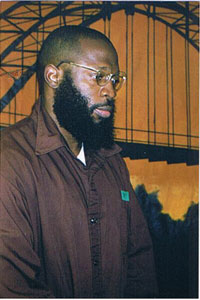
Katherine Williams still remembers coming downstairs that night and seeing her nephew on the foldout bed. “He wasn’t supposed to bring girls home,” she says. “But he did.”
At the time George Booker was 18 years old. Bringing a girl home
wasn’t allowed. But it could’ve saved his life-if his aunt had ever been called to testify on his behalf.
“After he was arrested,” says Williams, “I called his defense attorney. I told him I saw George home that night, and he said he’d call me back, but I never heard from him.”
Booker became one of three men convicted in the January 1981 murder of Paul Lehman, who worked a lottery stand at the corner of Germantown and Lehigh avenues.
Williams remembers seeing Booker at home because she was still mad at him the next morning for breaking house rules. On her way to work, a neighbor asked if she’d heard about Lehman’s murder.
“I thought that was awful,” she says. “And when George got arrested, I was surprised. Because I saw him myself-at home.”
Booker has now served 23 years in prison on his way to completing a life sentence.
In letters to PW he’s described the challenges he faces. “The way I see my days is similar to a goldfish in one of those small bowls,” he writes. “There is a direct route from the chow hall and the yard and in-between is where I am housed. Just like the fish bowl, the fish can swim from one end of the bowl to the other and in between that is where the fish lives.”
Now the Innocence Project at the Cardozo School of Law at Yeshiva University in New York is reviewing Booker’s case. The project, founded by Barry Scheck and Peter Neufeld, is famous in legal circles for exonerating 174 inmates in 14 years.
For much of his incarceration Booker’s only advocate on the outside was Darlene Johnson, a woman who began visiting him in prison seven years ago. “I know the saying that everyone in prison says they’re innocent,” says Johnson. “But I believed George, and when I started looking at the case, I saw it was really true. He didn’t do it.”
PW has also taken a close look at Booker’s case. He and his co-defendants were put away primarily on the testimony of one man, Eric Murphy, whose statements in court-at least where Booker was concerned-didn’t match the information he initially gave police.
Murphy first appeared of his own volition almost a year after the murder, and fingered two suspects.
“Two of the males I knew from before,” Murphy told city detectives. “One of the males was Michael Sanford, and the other male was a guy named Spud.”
Spud turned out to be Tyrone Payne.
“The third guy,” continues Murphy’s statement, “I did not know but he was a tall black guy. He had on a black leather jacket.”
Murphy’s appearance must’ve seemed a godsend to investigators, who knew little more than the fact that Lehman had been shot and killed in a robbery near his home on the 1100 block of Lehigh Avenue.
Police took a second statement from Murphy roughly 24 hours later. This time he identified the first two men from photos, referring to the third man only as “the other guy.”
Those first two statements cover 10 handwritten pages.



